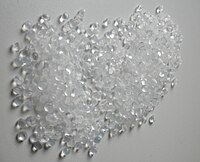
Photo from wikipedia
Abstract In the present work, polymer-enhanced ultrafiltration (PEUF) was used to study the purification of coloured wastewater. Methylene blue (MB) and methyl orange (MO) dyes were removed from aqueous solutions… Click to show full abstract
Abstract In the present work, polymer-enhanced ultrafiltration (PEUF) was used to study the purification of coloured wastewater. Methylene blue (MB) and methyl orange (MO) dyes were removed from aqueous solutions using water-soluble polymers: poly(2-acrylamide-2-methyl-1-propanesulfonic acid) (PAMPS) and poly(diallyldimethylammonium) chloride (PDDA), respectively. The PEUF technique has the advantage that it can be performed in homogeneous media to clean wastewater, where the novelty focuses on the water-soluble polymers used. Both polymers were first fractionated using an ultrafiltration membrane composed of regenerated cellulose with a molecular weight cut off (MWCO) of 10 kDa followed by subsequent freeze-drying. The removal of both dyes by ultrafiltration in the absence and presence of polymer was systematically studied. The performance of the polymers was studied under different parameters, such as the effect of the MWCO for the ultrafiltration membrane, the pH of the solution, the polymer:dye molar ratio, the initial dye concentration, the interference effect of NaCl and Na2SO4, and consecutive cycles of sorption-desorption. Under optimal conditions, a maximum removal efficiency of approximately 98% and 90% was achieved for MB and MO at pH 6.0 using initial MB and MO concentrations of 3.5 mg L-1 and 80 mg L-1, respectively, together with an ultrafiltration membrane with a MWCO of 10 KDa. The presence of interferents in the PEUF process was found to be not significant for dye elimination. Finally, the reusability of both polymers was demonstrated to be effective after four sorption-desorption cycles.
Journal Title: Journal of Environmental Chemical Engineering
Year Published: 2021
Link to full text (if available)
Share on Social Media: Sign Up to like & get
recommendations!